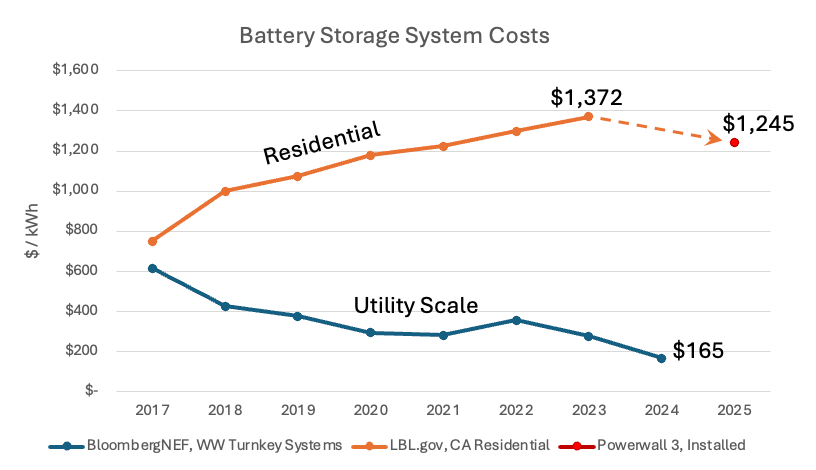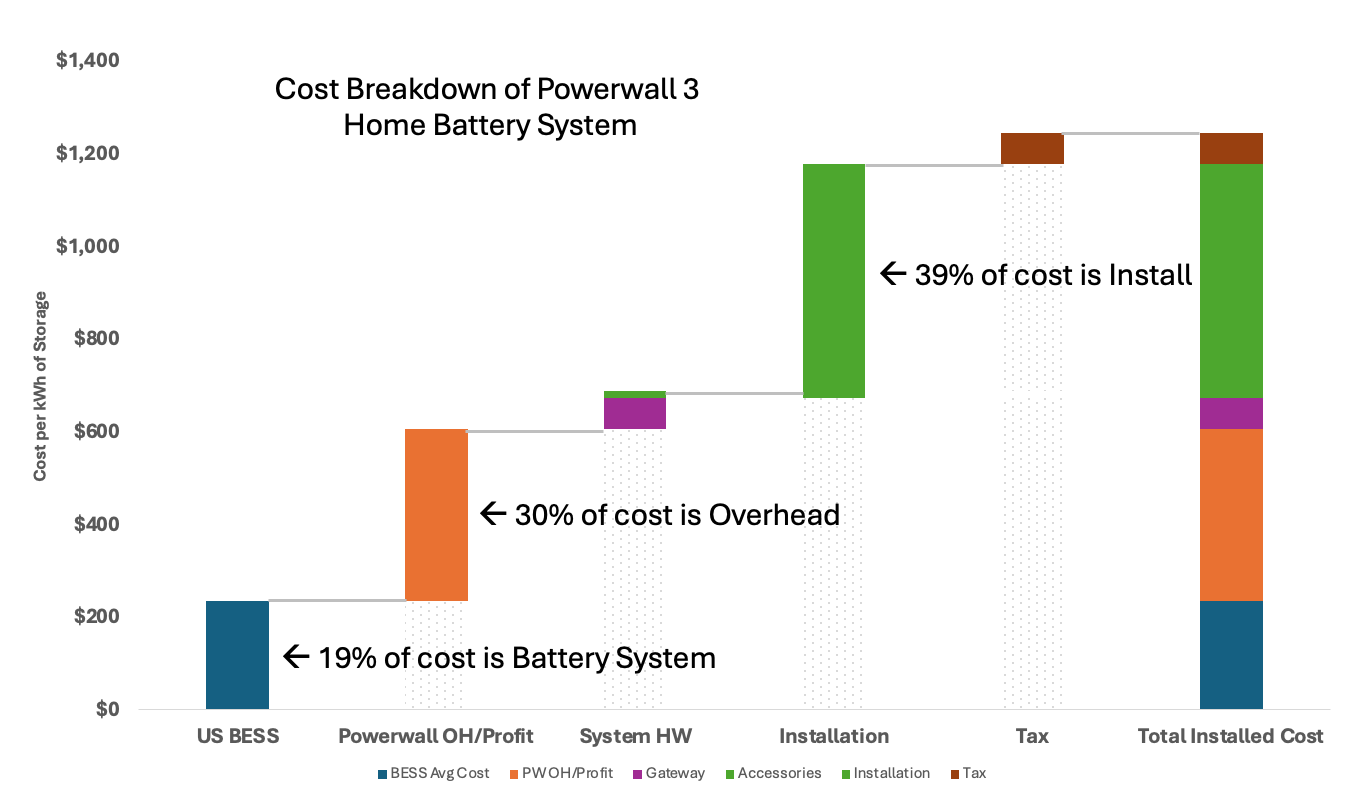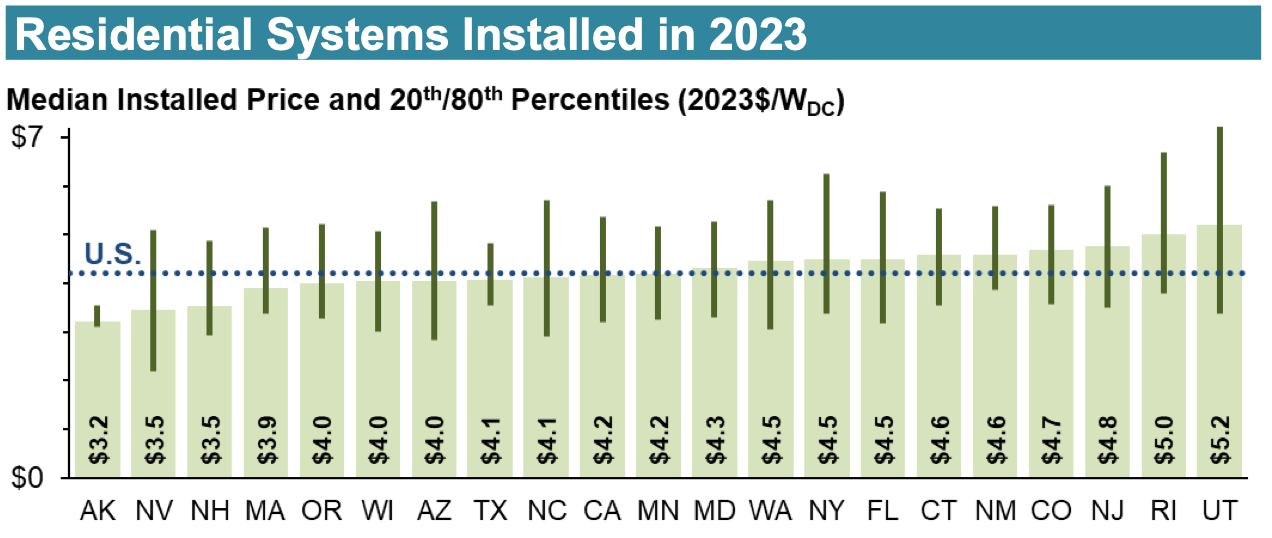Why are “home battery” systems so expensive?
Should they go the way of the “home motor”?

Global turnkey Battery Energy Storage System (BESS) prices fell ~40% YoY in 2024 to about $165/kWh, the steepest drop since BloombergNEF began its survey. This report got a lot of excited coverage when released. Yet U.S. home storage systems have actually gotten more expensive and remain pricey - a Tesla Powerwall 3 home battery costs almost $17,000 installed in August 2025, or $1,245/kWh1 - 7.5x the cost.

Even taking into account regional price spreads - China at ≈$101/kWh vs U.S. ≈$236/kWh for turnkey systems - the Powerwall home battery is still 5.3x these costs. Even with the current 30% tax credit, set to expire at the end of 2025, it’s “only” 3.7x the cost. What gives?
What “cheap batteries” do — and don’t — cover
BNEF’s “turnkey system” includes the battery rack (DC block), PCS/inverter, and EMS — more than just cells.
However, in residential PV+storage, there’s much more involved.
Using Tesla’s online quoting tool as a guide, they break out the following costs in addition to the Powerwall 3 itself (listed at $8,200 before tax incentives) for a typical installation:
- Gateway - $900
- Accessories - $200
- Installation - $6,600
- Tax - $918
Summarized in a graph, the cost stack looks like this, with install costs representing nearly 40% of the total (again, pre-incentives):

The residential home battery storage soft-cost stack that won’t budge
Of course, bigger battery systems are cheaper per watt (economies of scale), but soft costs dominate the last mile of home battery installations. The cost to install the Powerwall expansion pack at the same time (another 13.5kWh of capacity) is an additional $5,300, or only $393/kWh. Most of the Powerwall home battery system cost goes into the installation work and associated hardware, not the battery system itself.
Dealer/financing fees commonly embedded in residential prices can add ~5–50% to the reported system price. These fees are only partially reflected in the above cash prices, but would add to the cost of any systems purchased this way.
Large state-by-state price effects in the underlying solar installation costs (~$2/W, or +/-25% from median) and high variability signal policy, permitting, and market-structure drivers beyond hardware, likely also reflected in home battery storage systems’ installed price, as many battery systems are installed with solar. (Lawrence Berkeley Lab’s “Tracking the Sun” report.)

Battery market structure and scale
Utility-scale buyers benefit from bulk procurement, standardized designs, and fierce global competition (particularly in China), which push turnkey costs down much faster than in fragmented regional markets.
The residential home battery storage market in the US is highly fragmented, closely aligned with the 10,000 solar installers here, although just 10 companies do about 1/3 of all the installations. This market will see massive disruptions with the sunsetting of the 30% tax credit at the end of 2025, which will cause an immediate increase of +43% to the net price to the consumer for these systems (remember math - if something costs $70 – a 30% discount off $100 – increasing the price by +$30 = +$30 / $70 = +43%).
What could actually lower home battery system prices
Attack soft costs
Streamlined permitting and standardized designs. Eduardo Pelegri illustrates some detailed new battery design examples that may help. But these are still pretty complex systems.
DIY installation
What if you don’t need someone to install the battery at all? There are a number of vendors selling a “battery on wheels” that you just plug your devices in to and can use around your home -
- Anker Solix F3800 - 3.8kWh for $2799 ($737/kWh)
- Zendure SuperBase - 6.4kWh for $4798 ($750/kWh)
- EcoFlow Delta 3 Pro - 4.1kWh for $2,699 ($658/kWh)
- Jackery Explorer 5000 Plus - 5kWh for $3499 ($700/kWh)
- Pila is introducing a more fashionable, “distributed” home battery - 1.6kWh for $1299 ($812/kWh)
These devices provide easy backup and many can be configured to run as Uninterruptible Power Sources (UPS), and can also recharge from portable solar panels you just plug in (for long-term outages). Average prices for these devices are 1/2 to 2/3 the cost per kWh of the Powerwall, which closely ties to home battery system costs if you were to simply eliminate the installation charges.
Ditch the “home battery” concept altogether
The first electric motors in the 1920’s were sold separately as “home motors” that could power different devices around the home - much like “home batteries” are marketed today. But as we know, electric motors are now embedded in nearly every electrical appliance - dishwashers, refrigerators, AC units, washing machines, dryers, etc. Perhaps “home batteries” will go the way of the “home motor” dinosaur, as highlighted by some of these devices -
- Electric stoves: Impulse cooktop and Copper range/stove have built-in batteries to avoid electric system upgrades needed for induction stoves.
- Heat Pump/AC: Ecoflow Wave 3 makes a portable heat pump, 6,100 BTU heating / cooling, that runs for 8 hours with add-on 1kWh battery pack.
- Lighting: GE Battery-backed light bulb, works for 5 hours in an outage.
- Garage Door Opener: Chamberlain/Liftmaster makes battery-backed garage door openers.
- Internet/WiFi: Xfinity Storm-ready WiFi comes with 4-hour battery and cellular back-up for your Internet.
- And of course there’s lots of small battery-operated appliances... robot vacuums, dusters, mixers, leaf blowers, etc.
Conclusion
Battery hardware is cheap in the big leagues and at the component level—but home battery storage today mostly lives in a soft-cost world. Until we either standardize the residential playbook and wring out complex design, financing, permitting, and sales frictions, or eliminate the installation altogether through plug-and-play or built-in batteries, households won’t feel the “all-time low” prices the grid is seeing.
- Complete installed cash pricing of $16,818 in SF Bay Area for a 13.5 kWh Tesla Powerwall 3, not including tax incentives, accessed from tesla.com on 8/21/25. ↩︎
